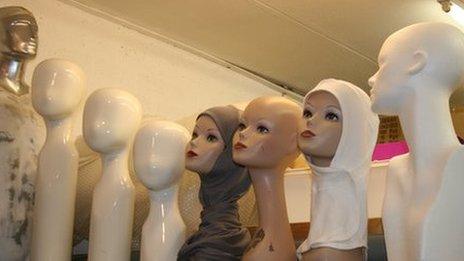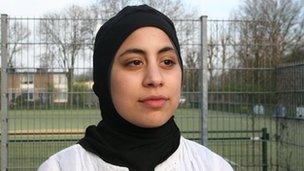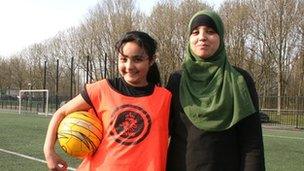Dutch design challenges Fifa's football hijab ban
- Published

A Dutch designer has created a hijab aimed at convincing the world football governing body Fifa to overturn its ban on women wearing headscarves on the pitch.
Players were prevented from wearing the hijab at top levels of the game for safety reasons, and because of rules stating that religious symbols were not allowed.
Critics say the ban promotes inequality at the highest level of the world's most popular game.
A Facebook page called "Let Us Play, external", which supports players' rights to wear a headscarf has already generated more than 60,000 likes.
And speculation is growing that the ban could be lifted this summer if the Dutch-designed hijab is given Fifa's seal of approval.
Out on the outskirts of Utrecht, 14 breathless girls are careering up and down the pitch.
VV Hoograven are playing DVSU. The girls are aged between eight and twelve.
The visiting team is made up of tall fair-haired light-skinned girls. All the girls in the home side are Muslims of Moroccan descent.
'Low participation'
If the hijab ban stays, some of these players will not be able to take their talents far beyond their home ground - a concern to former Jordanian women's team coach Hesterine de Reus:

Dutch designer Cindy van den Bremen says the hijab's design makes it safe and comfortable
"I struggled a lot to get girls involved in the game in Jordan. We have to encourage Muslim girls to start playing.
"Their participation in sport is low anyway, and I think in football we make it worse with the existence of these rules."
Hesterine de Reus was in charge of Jordan in a game against Iran in the 2012 Olympic qualifiers. But moments before kick-off, the Iranian team was disqualified for refusing to remove their headscarves.
The decision caused outrage in Iran, with President Ahmadinejad accusing Fifa of acting like dictators and colonialists.
According to Fifa, more than 29 million women and girls around the world play the game - a figure they say is "rising rapidly all the time".
But there are fears that its potential in Muslim communities is being inhibited by the ban.
Last year, a group led by Fifa's Vice President, Prince Ali Bin al-Hussein of Jordan, successfully convinced world football's rule-making body, Ifab, that the hijab was a cultural rather than a religious symbol.
This means only the safety concerns now stand between women wearing hijabs and their being allowed to compete at international level.
Dutch design
On the ground floor of a modern artists studio in the southern Dutch city of Eindhoven, surrounded by hijab-wearing mannequins, Dutch designer Cindy van den Bremen shows off the headscarf that Ifab is eyeing up as a possible model to overcome those last remaining concerns.

VV Hoograven coach Yousra Slaoui thinks the new design is safer for football than the traditional hijab
"What makes Capsters unique is the ready-made design, so you don't need knots or pins to tie it around your head. And it's made in stretchable materials so it's a very comfortable hijab," she says.
Ms Van den Bremen demonstrates how the new style works: "I put it over your head, make sure all your hair is underneath and then just fasten with the Velcro closing."
The fastening means that if an opponent grabs a hijab from behind it will easily come off, therefore minimising the risk of choking or strangulation.
But it must meet the players' standards too. VV Hoograven coach Yousra Slaoui has been trying it out: "I like it. It's safer than the old traditional design, which had lots of needles and pins that could slip off and go into your ear. I think the girls will be excited about this one."
Sport v culture
Football is still a male-dominated sport, and for some Muslim men, the idea of their wives or daughters kicking a ball around in public is unacceptable.
But Naima Loukili, who has come to see her daughter play for VV Hoograven, says it is a social rather than a religious barrier:

Amal Loukili (L, pictured with her mother Naima) has high hopes of playing at the top level of football
"It's not something Islam says. It's just our culture. Islam supports women to go out and do sport or do whatever they want. I'm happy my daughter has the opportunity to do this."
And 10-year-old Amal Loukili is not letting any cultural considerations interfere with her ambitions. "I want to play for Barca one day or maybe even Holland," she says.
The idea of a possible amendment to international football's rulebook that would allow headscarves on the pitch has reignited a religious debate in right-wing politics too:
"I'm very happy that women in Islamic countries are allowed to play football. That's a step forward," acknowledges Geert Tomlow, a former member of the anti-immigration Dutch Freedom Party.
"But by pushing or ordering or by blackmailing your woman to wear a scarf then it's a problem, then it's a symbol of oppression."
Back in the studio, designer Cindy van den Bremen insists her hijab is designed to empower women and give them the freedom to choose.
"Most of the women and girls I spoke to were very keen to wear a hijab on the pitch, contradicting the image I had.
"We think it's a woman's choice whether they want to cover themselves and not anyone else's - including Fifa."